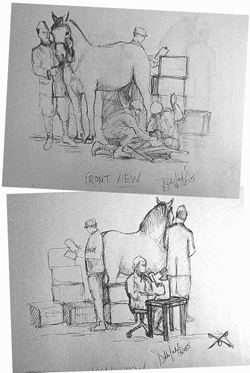A century of history in bronze
The Army Veterinary Corps will mark its 100-year anniversary June 3 with the unveiling of a bronze statue at the U.S. Army Medical Department Museum at Fort Sam Houston in San Antonio.
The statue features four Army veterinarians, each engaged in a veterinary service at a particular time of the Veterinary Corps’ history, from its creation in 1916 to the present day.
The Veterinary Corps commissioned San Antonio artist Donna Dobberfuhl to create the commemorative statue, the cost of which the AVMA Board of Directors agreed to cover last July. Dobberfuhl was chosen because of her work over a career spanning more than four decades, including the statue, The Price of Freedom: Fully Paid, on display at the National Prisoner of War Museum in Andersonville, Georgia. She said the Veterinary Corps came to her with an idea for the statue.


Visible from the statue’s front is a veterinarian in a World War I Army uniform standing with a horse. To their left, a wounded military dog lying on a stretcher is treated by a modern-day veterinarian as the dog’s handler comforts the animal. From behind, a veterinarian from the Cold War era is seen inspecting crates of military rations. To that figure’s left, a female veterinarian from the time of the Vietnam War sits at a field desk, peering through a microscope at a slide.
“These figures, they aren’t made-up people or animals. They’re either based on real individuals or representative of real individuals,” Dobberfuhl said. “I try to find out as much as I can about an individual. I do as much as I can to research. It’s one of the things I love most about what I do, is I get to learn about my subjects.”
The figures are around 10 percent larger than life so that they appear normal size outside. “You have to overscale outdoor sculptures because the sun absorbs form, so you make figures slightly larger to compensate,” Dobberfuhl explained. The sculpture contains a great deal of detail, she added, noting that the patches, ranks, and insignia are all authentic.
To celebrate the Army Veterinary Corps’ centennial, the AVMA and the American Veterinary Medical Foundation are establishing a scholarship program for U.S. military veterans interested in a career in veterinary medicine. AVMA members who have served or are currently serving in the military will be contacted in the coming months about supporting the scholarship. Plans include providing donors at select levels with a maquette, a miniature version of the statue. For more information, contact Jodie Taggett, AVMA director of partnerships and program development, at jtaggett avma [dot] org (jtaggett[at]avma[dot]org).
avma [dot] org (jtaggett[at]avma[dot]org).
Related JAVMA content:
Board acts on wellness and food security measures, elects officers (Sept. 1, 2015)